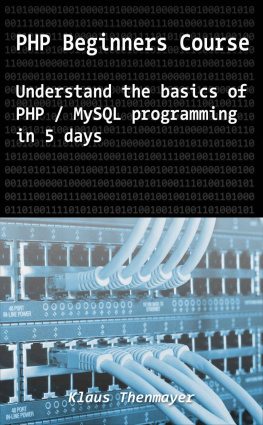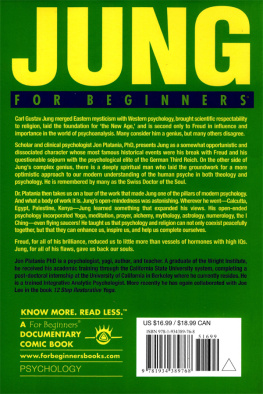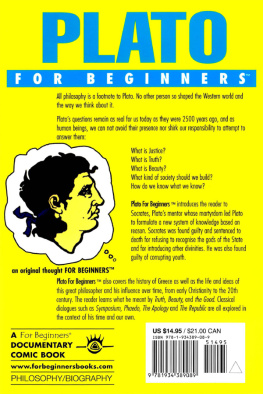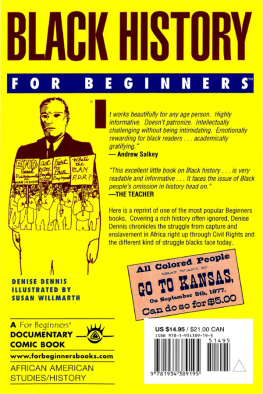Thenmayer - PHP Beginners Course
Here you can read online Thenmayer - PHP Beginners Course full text of the book (entire story) in english for free. Download pdf and epub, get meaning, cover and reviews about this ebook. year: 2016, publisher: UNKNOWN, genre: Computer. Description of the work, (preface) as well as reviews are available. Best literature library LitArk.com created for fans of good reading and offers a wide selection of genres:
Romance novel
Science fiction
Adventure
Detective
Science
History
Home and family
Prose
Art
Politics
Computer
Non-fiction
Religion
Business
Children
Humor
Choose a favorite category and find really read worthwhile books. Enjoy immersion in the world of imagination, feel the emotions of the characters or learn something new for yourself, make an fascinating discovery.
PHP Beginners Course: summary, description and annotation
We offer to read an annotation, description, summary or preface (depends on what the author of the book "PHP Beginners Course" wrote himself). If you haven't found the necessary information about the book — write in the comments, we will try to find it.
PHP Beginners Course — read online for free the complete book (whole text) full work
Below is the text of the book, divided by pages. System saving the place of the last page read, allows you to conveniently read the book "PHP Beginners Course" online for free, without having to search again every time where you left off. Put a bookmark, and you can go to the page where you finished reading at any time.
Font size:
Interval:
Bookmark:
Understand basics of PHP / MySQL programming in 5 days
Copyright 2017 Klaus Thenmayer
All rights reserved
Initialrelease May 2012 as ebook at Amazon KDP and Smashwords Inc.
English translation December 2016
6th edition January 2017
Allbrand and product names are trademarks of their respective owners. We accept noliability for any damage to software / hardware, all information withoutguarantee. The text of this book may not be reproduced without permission. Whenquoting please rely on the Amazon book page link.
Coverdesign: Klaus Thenmayer
Cover Photo: MWiner / Fotolia.com
So youwant to learn quickly how to program in PHP? This book is the right choice. Youwill learn within easy-to-understand chapters the basics of developing dynamicwebsites in PHP. It places special emphasis on full code examples which runindependently of each other.
Itbegins with setting up the development environment on your computer.Immediately after you write your first PHP script and execute it in your newlyinstalled server. Then you will learn how you can query information and controlthe program sequence in order to create dynamic websites. You also learn howyou can save the information in databases or files, and read again.
Finally,you will get a short introduction to more advanced topics such as writing cleanand safe program code.
Youwill not become a professional web developer by reading only this book, but youwill get very good fundamentals and a guide in programming your first dynamicwebsites.
Thereis no special knowledge necessary. If you want to learn programming in PHP, Iassume that you know how to install applications on your computer.
Someknowledge of HTML to format texts cannot harm but is not mandatory and it willbe the main HTML code explained in the appropriate places.
Onhardware you need is a computer with monitor, mouse and keyboard. Since weprogram websites, of course an internet connection helps to get the neededsoftware and more tutorials, but isnt needed during development, as we installour own little server. You only need to download some (free) software from theInternet, more on that later.
Youare free, what operating system you use for development. The book will show youhow to do the installation of a PHP server with MySQL support on Windows, Linuxand MacOS and it will give you some examples of modern text editors.
PHP isa scripting language that is used primarily to develop dynamic webpages. PHPscripts are executed directly on the server and not in the browser of avisitor.
PHPwas developed in 1995 by Rasmus Lerdorf. His goal was to create a simplereplacement for the collection of use-ful Perl scripts. This is how PersonalHome Page Tools came into being. Soon after, he recreated the tool collectionin the programming language C. Today, PHP is still developed in C, a verypowerful programming language. It was soon fol-lowed by the first version, PHP/ FI (Form Interpreter).
In1998, Andi Gutmans and Zeev Suraski, in cooperation with Lerdorf, created PHP 3from scratch to make it ready for use, particularly in the booming e-commercebusiness. Gutmans and Suraski founded the company Zend Technol-ogies Ltd.,which contributed the main parts of PHP 4.
In2004, PHP5 introduced enhanced support for object-oriented programming andgreatly increased the speed of the PHP interpreter.
Elevenyears later, in 2015, PHP 7 was released. It is powered by a new engine with afast speed. PHP 6 was skipped because projects planned to carry out the programwere never finished and so the developers focused on a completely new coreengine. Most scripts execute twice as fast as in PHP 5.x. The majority of oldPHP 5 scripts only need small changes to run in PHP 7. Scripts in this book areall updated to be fully compatible.
OnWindows, the prefabricated server packages make it extremely easy to installthe server. For the development, I prefer the package of Xampp(www.apachefriends.org).
Downloadthe installer for Windows and run the installation. I recommend to keepC:/xampp/ as the default folder path. If you install the package underC:/Programs/XAMPP/, the server may make problems because the necessary filepermissions are not set correctly. During the installation, it will be askedwhether the individual server components should be installed as a service inthe operating system. You must not do so, otherwise the server will constantlyrun in the background (until you stop the services manually), consumeresources, and will be continuously available over the network.
InLinux, it would be better to install an Apache web server and a MySQL serverusing the Package Manager and to perform the configuration manually. But, forthis book, I recommend that the beginners use a prepared package fromwww.apachefriends.org, which has all the necessary server features and PHPextensions. Beneath the download links, you will find the Linux installationinstructions and some tips on how you can start and stop the server quickly.
Thereare Apachefriends.org packages even for MacOS. But I prefer the package of MAMPfor MacOS users. Its oper-ation is similar but has given me fewer problems. Theapplication is available for free under www.mamp.info. There is also a paid Proversion, but we do not need this for our first programming experience. Afterdownloading the setup file, please install MAMP in your Application folder.
Allthe abovementioned server packages contain a directory with the label htdocs.We will use this to store files that can be accessed via a browser from theserver. So, open your browser and enter the following URL: http://127.0.0.1
UnderMacOS, you have to enter the port number of the server (the default number is 4444,so the entire URL should be: http://127.0.0.1:4444)
Youshould be greeted from your server packages website (XAMPP / MAMP) and receivesome information about the server.
127.0.0.1always leads to the local computer. This means that the browser tries to find alocal web server. Alternatively, you could use http://localhost. This shouldlead to the same result.
Eachoperating system has a lot of good text editors. However, in this case,Microsoft Office Word or LibreOffice Writer cannot be regarded as text editorsbecause they save a lot of information about the page and text formatting apartfrom the text. A text editor saves the exact characters of the entered text asit appears in the editor. Modern text editors colour text to make it morereadable. The colouring will not be saved, but shown dynamically when youreopen the file. This function is called syntax highlighting. Syntax is theterm used to describe the code, and highlighting it in a text editor means thatvarious commands and functions of a programming language are coloured.
Thereare also Integrated Development Environments (IDEs), which help a lot to writeand manage the program code and all other parts of a software project. IDEsautomatically detect cross-references to functions in the program code and candisplay the recently used functions while writing notes.
Thereare large IDE projects, which are available as open source items, or underdifferent licenses for all operating sys-tems. Many developers use the IDEs Eclipse(www.eclipse.org) or NetBeans (www.netbeans.org).
If youhave a low-performance computer or want to quickly test some short PHP scripts,then I recommend using the text editor jEdit, which has been developed as anopen source software and can be downloaded from www.jedit.org. In the largerLinux distributions, jEdit is available via a Software Channel (PackageManager) in a somewhat outdated version.
Font size:
Interval:
Bookmark:
Similar books «PHP Beginners Course»
Look at similar books to PHP Beginners Course. We have selected literature similar in name and meaning in the hope of providing readers with more options to find new, interesting, not yet read works.
Discussion, reviews of the book PHP Beginners Course and just readers' own opinions. Leave your comments, write what you think about the work, its meaning or the main characters. Specify what exactly you liked and what you didn't like, and why you think so.













